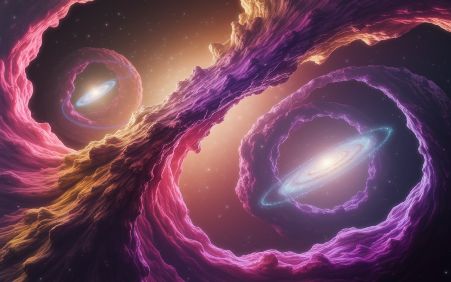Invisible cosmic structures shape our universe. Scientists use advanced tools to find them. They help us understand the hidden universe. These hidden objects include dark matter halos and intergalactic gas. They affect light and gravity. They remain invisible to normal telescopes. This article explains how scientists detect invisible cosmic structures.
The Mystery of Hidden Space
Many parts of space stay unseen. Scientists know they exist through indirect evidence. Invisible cosmic structures include dark matter and cosmic filaments. These hold galaxies together. Researchers study their influence on visible matter. Their presence affects light paths from distant stars.
Tools for Detecting the Invisible
Scientists use various tools to study these unseen structures. Telescopes that detect x-rays help locate hot gas. Gravitational lensing shows how hidden matter bends light. Simulations model invisible cosmic structures in space. They guide our search and improve our knowledge.
Gravitational Lensing as a Key Method
Gravitational lensing bends light around hidden objects. This method helps detect dark matter clumps. Light from distant stars changes direction. This proves that invisible cosmic structures affect gravity. Scientists study this bending to map unseen space.
X-Ray Observatories Reveal Hidden Gas
Hot gas in space emits x-rays. Special telescopes detect these emissions. They find invisible cosmic structures like galaxy clusters. The x-ray data shows dense regions in space. These regions often hold large amounts of dark matter.
Cosmic Microwave Background and Structures
The cosmic microwave background helps trace early structure formation. Small fluctuations in temperature reveal hidden masses. These patterns link to invisible cosmic structures. They help scientists map the universe’s shape and matter distribution.
Mapping the Cosmic Web
Galaxies form threads called the cosmic web. Between the threads lie voids. The web contains invisible cosmic structures. Scientists map this web using light and gravitational shifts. This reveals the large-scale pattern of the universe.
Role of Radio Waves in Detection
Radio waves travel through gas and dust. They uncover invisible cosmic structures hidden behind clouds. Large radio telescopes scan deep space. They find hidden hydrogen gas and distant galaxies. These help locate unseen cosmic structures.
21-Centimeter Hydrogen Signal
Hydrogen atoms emit a signal at 21 centimeters. This signal travels across the universe. Scientists detect it to trace hydrogen clouds. These clouds form part of invisible cosmic structures. The signal also reveals past cosmic events.
Computer Simulations Guide Research
Scientists build simulations of the universe. These include known and unknown matter. They compare real data with models. Simulations help find invisible cosmic structures. They also predict where new structures might lie hidden.
Matching Simulations With Observations
Simulations create expected maps of the universe. Observations then confirm those predictions. Differences help refine the models. This improves our search for invisible cosmic structures. It increases the accuracy of cosmic mapping.
Role of Fast Radio Bursts
Fast radio bursts travel across long distances. They pass through invisible cosmic structures. The bursts slow and scatter. This helps measure matter in space. Scientists study the changes to detect hidden material.
Dispersion Measures in Radio Signals
As radio waves pass through space they change. Scientists measure these changes. These measurements reveal the presence of invisible cosmic structures. They also show how matter spreads through the universe.
Neutrino Astronomy Opens New Windows
Neutrinos are tiny particles that rarely interact with matter. They pass through stars and galaxies. Special detectors capture them underground. These reveal invisible cosmic structures. They come from distant sources and carry hidden information.
IceCube Neutrino Observatory
IceCube detects neutrinos in Antarctica. It finds high-energy particles from deep space. Their paths reveal invisible cosmic structures. Neutrino data helps map the universe’s hidden matter.
Discoveries Through Weak Lensing
Weak gravitational lensing causes small changes in light. These shifts come from invisible cosmic structures. Scientists study these to find dark matter. They build maps showing unseen mass across the universe.
Data From DES and Euclid
The Dark Energy Survey and Euclid mission gather weak lensing data. These projects find invisible cosmic structures. They measure the universe’s expansion and matter spread. The results help solve cosmic mysteries.
Using Galaxy Motions to Detect Structures
Galaxy movements show the pull of hidden forces. Scientists track these motions. The patterns point to invisible cosmic structures. They prove unseen matter shapes cosmic flows and gravity.
Peculiar Velocities and Hidden Mass
Galaxies move differently from predictions. These peculiar motions reveal invisible cosmic structures. The added pull comes from dark matter. Scientists use this to map unseen parts of space.
Intergalactic Medium as a Structure
The intergalactic medium holds gas between galaxies. It remains mostly invisible. Scientists study its absorption of light. These absorption lines show invisible cosmic structures. They reveal gas spread across space.
Lyman-Alpha Forest Observations
Light from quasars shows lines called the Lyman-alpha forest. These lines appear due to gas clouds. They trace invisible cosmic structures in space. Scientists analyze them to study cosmic evolution.
Challenges in Detecting the Invisible
Finding invisible cosmic structures is not easy. Signals can be weak or distorted. Equipment must be very sensitive. Many tools work together to get a full picture. Scientists also face limits from background noise.
Technological Advances Help
New technology improves detection. Bigger telescopes and faster computers help find invisible cosmic structures. Data processing reveals faint patterns. AI helps spot hidden signals in noisy data.
Pros and Cons of Detection Methods
| Method | Pros | Cons |
|---|---|---|
| Gravitational Lensing | Maps dark matter directly | Needs background light |
| X-Ray Observations | Finds hot gas and galaxy clusters | Cannot detect cold dark matter |
| Radio Telescopes | Detect hydrogen and hidden galaxies | Limited resolution |
| Neutrino Detection | Penetrates deep space | Requires large underground facilities |
| Simulations | Predicts invisible cosmic structures | Depends on model assumptions |
| Weak Lensing | Measures large-scale mass distribution | Needs accurate shape measurement |
The Future of Cosmic Detection
New missions will deepen our understanding. The James Webb Space Telescope will study early galaxies. SKA will scan deep radio waves. These will uncover more invisible cosmic structures. The future holds many discoveries.
International Collaboration Grows
Countries work together on space missions. Shared data helps find invisible cosmic structures. Scientists build global observatories. These reveal the full cosmic picture. Collaboration speeds up discovery.
Summary
Scientists use many tools to detect invisible cosmic structures. They combine light bending with radio signals and computer models. These methods uncover the hidden fabric of the universe. Research continues to improve our understanding.
Frequently Asked Questions
What are invisible cosmic structures?
They are space features we cannot see directly. They include dark matter and intergalactic gas. Scientists detect them indirectly.
How does gravitational lensing help?
It shows how hidden mass bends light. The changes in light paths reveal invisible cosmic structures.
Can radio waves detect hidden space?
Yes. They pass through dust and gas. They help find hydrogen and galaxies hidden from view.
What role do neutrinos play?
Neutrinos pass through matter. Their paths reveal hidden cosmic events. They help detect invisible cosmic structures.
Why are these structures important?
They hold the universe together. They shape galaxies and influence cosmic evolution. They explain dark matter and cosmic flow.





